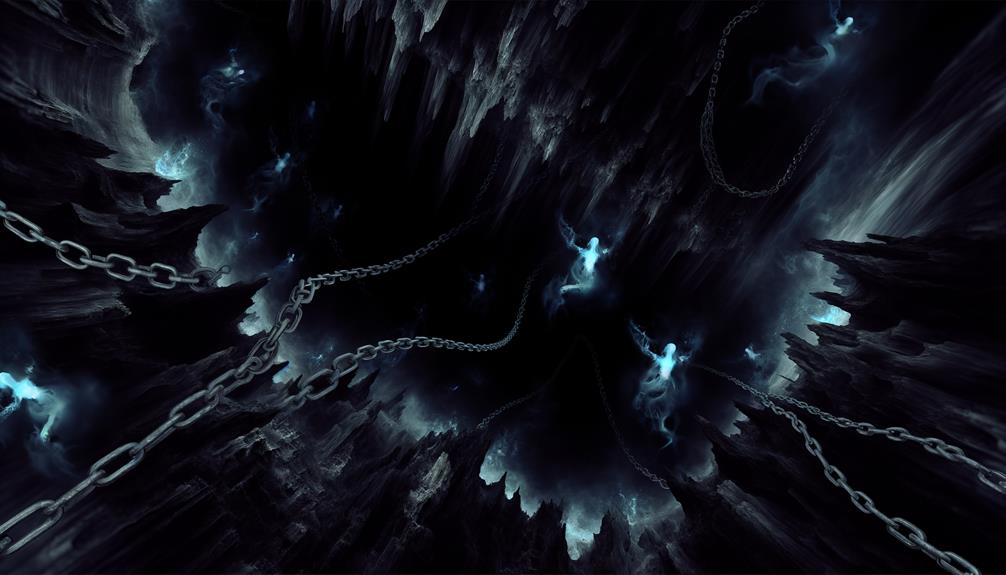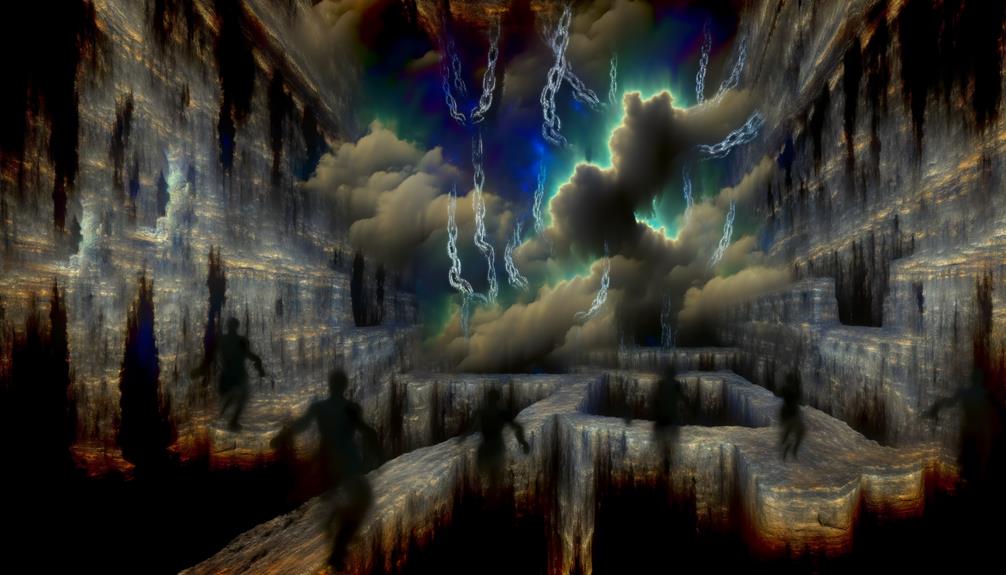Tartarus Meaning In The Bible: Place of Judgment
In the Bible, Tartarus is primarily referenced in 2 Peter 2:4, where it is described as a place of divine retribution and temporary containment for fallen angels. This term, borrowed from Greek mythology, is distinct from Hades, the general abode of the dead, and Gehenna, the final place of eternal punishment.
Tartarus emphasizes the severity of divine justice and the consequences of rebellion against God’s authority within Christian eschatology. Its unique role in theological constructs highlights the multifaceted nature of afterlife concepts in early Christian thought, providing a deeper understanding of divine judgment and morality.
Discovering more will illuminate these intricate theological distinctions.

Tartarus Meaning in the Bible: Biblical Definition and Spiritual Significance
| Concept | Biblical Meaning | Scriptural Insight |
|---|---|---|
| Tartarus | A deep abyss or prison | Mentioned in 2 Peter 2:4 |
| Place of Judgment | Reserved for fallen angels | Signifies God’s authority and justice |
| Spiritual Imprisonment | Separation from God’s presence | Represents ultimate divine punishment |
| Greek Influence | Term derived from Greek mythology | Used uniquely in New Testament context |
| Temporary Holding | Awaiting final judgment | Not the final hell but a holding place |
Biblical References to Tartarus

In the Bible, Tartarus is specifically mentioned in 2 Peter 2:4 as the place where fallen angels are held in chains of darkness until the day of judgment. This reference to Tartarus signifies a domain of divine retribution and containment for celestial beings who transgressed divine law.
The theological implications suggest that Tartarus serves as a temporary holding place, distinct from Hades or Gehenna, highlighting the structured cosmology within biblical eschatology.
Historically, the term ‘Tartarus’ in this situation may reflect an intersection between Jewish apocalyptic literature and Hellenistic influences, providing a complex backdrop for interpreting divine justice.
This single mention underscores the gravity of divine punishment and the ultimate authority of divine judgment within Christian theology.
Greek Mythology Origins

Drawing from its biblical mention, the concept of Tartarus also finds its roots in Greek mythology, where it is depicted as a primordial abyss used to imprison the Titans and other malevolent entities.
In Hesiod’s ‘Theogony,’ Tartarus is described as a deep, dark pit far beneath the earth, distinct from Hades, the domain of the dead. It is a place of eternal punishment and torment, reserved for those who defied the gods.
This mythological interpretation underscores the severity and depth of Tartarus, emphasizing its role as a cosmic prison in the Greek pantheon.
Understanding this background provides a richer theological and historical context, linking the ancient Greek cosmology with the biblical references to divine retribution and judgment.
Tartarus Vs. Hell and Hades

The distinctions between Tartarus, Hell, and Hades are rooted in both Greek mythology and biblical literature, each carrying unique connotations and theological implications.
While Tartarus in Greek mythology refers to a deep abyss used for the punishment of the wicked, its biblical references, particularly in 2 Peter 2:4, align it with a place of severe judgment distinct from the more general concepts of Hell and Hades.
Understanding these differences is essential for comprehending the theological narratives and eschatological themes that emerge within the biblical text.
Distinctions in Greek Mythology
Ancient Greek mythology presents Tartarus, Hell, and Hades as distinct territories with unique characteristics and functions within their cosmological framework.
Tartarus, often depicted as a deep abyss, serves as a prison for the Titans and a place of eternal punishment for the wicked. It is a domain of suffering far below the surface of the earth.
In contrast, Hades is the general underworld where souls of the deceased reside, governed by the god Hades. While Hades encompasses a broader scope, including both punishment and reward, Tartarus is specifically reserved for the most egregious offenders.
The concept of Hell, though sometimes conflated with Tartarus, is more aligned with later Christian interpretations of eternal damnation, and does not have a direct equivalent in Greek mythology.
Biblical References Explained
While Greek mythology provides a distinct framework for understanding Tartarus, Hades, and Hell, the Bible employs these terms differently, reflecting unique theological and eschatological perspectives.
Tartarus, mentioned explicitly in 2 Peter 2:4, is reserved for fallen angels, distinct from Hades and Hell.
In contrast, Hades, appearing in passages such as Luke 16:23, denotes the abode of the dead, akin to Sheol in the Old scripture.
Hell, often translated from ‘Gehenna’ in the New scripture, signifies eternal punishment for the wicked.
- Tartarus: Place for fallen angels (2 Peter 2:4)
- Hades: Temporary abode of the dead (Luke 16:23)
This differentiation underscores the nuanced biblical understanding of the afterlife.
Theological Interpretations and Implications
Understanding the theological interpretations and implications of Tartarus, Hades, and Hell requires examining their distinct roles within biblical eschatology.
Tartarus, mentioned in 2 Peter 2:4, is depicted as a specific place for the punishment of fallen angels, distinct from Hades and Hell.
Hades, often translated as ‘the grave’ or ‘the domain of the dead,’ serves as a temporary abode for souls awaiting final judgment, as seen in Luke 16:23.
Hell, or Gehenna, represents the final destination for the wicked post-judgment, characterized by eternal separation from God (Matthew 25:41).
These distinctions emphasize differing stages and purposes in the afterlife, enriching our understanding of divine justice and eschatological destiny within Christian theology.
Theological Interpretations

Exploring the theological interpretations of Tartarus within the biblical context necessitates an examination of scriptural references and early Christian writings to understand its role in eschatological doctrine.
Tartarus is often depicted as a place of divine retribution and punishment, distinct from other theological constructs such as Hades and Gehenna. Its interpretations have evolved through:
- Patristic Exegesis: Early Church Fathers like Origen and Tertullian provided foundational insights into Tartarus, often linking it to fallen angels.
- Apocryphal Literature: Texts outside the canonical Bible, such as the Book of Enoch, expand on Tartarus’ punitive aspects.
These interpretations highlight Tartarus’ enduring complexity in Christian eschatology.
Tartarus in New Testament

In the New Covenant, Tartarus is explicitly mentioned in 2 Peter 2:4, where it is described as the gloomy abyss into which God cast the sinful angels.
This reference is unique within the New Scripture and denotes a specific domain of punishment distinct from Hades or Gehenna.
The term ‘Tartarus’ reflects a borrowing from Greek mythology, where it signifies the deepest, most infernal region of the underworld.
Peter’s usage indicates a place of severe divine judgment reserved for fallen celestial beings, thereby reinforcing the gravity of their transgressions.
This theological context underscores the New Scripture’s broader eschatological themes, emphasizing divine justice and the ultimate fate of those who rebel against God’s sovereign order.
Symbolism and Imagery

While the term ‘Tartarus’ in the New Scripture is relatively rare, its rich symbolism and imagery evoke profound theological and eschatological implications. It is portrayed as a domain of utter darkness and confinement, often associated with divine judgment and the ultimate fate of fallen angels.
The term’s significance is multifaceted, encompassing:
- Divine Retribution: Tartarus symbolizes the severity of God’s judgment, echoing themes of justice and punishment.
- Separation: It represents a profound separation from the divine presence, emphasizing the consequences of spiritual rebellion.
These elements collectively contribute to the understanding of divine justice and eschatology within the biblical narrative.
Tartarus in Christian Doctrine

Rooted in early Christian theology, the concept of Tartarus elucidates the gravity of divine retribution and the immutable nature of eschatological judgment.
Tartarus is referenced explicitly in 2 Peter 2:4, where it is described as a place of confinement for fallen angels, symbolizing the severe consequences of rebellion against divine authority. This theological construct underscores the early Church’s emphasis on the inevitability of divine justice.
Modern Perspectives on Tartarus

In contemporary discourse, Tartarus occupies a multifaceted role, intersecting theological interpretations, cultural representations, and academic debates.
Modern theologians explore its significance within a broader eschatological framework, while Tartarus appears frequently in literature and media, reshaping its connotations for new audiences.
Furthermore, scholars engage in rigorous discussions regarding its historical context and linguistic origins, contributing to an evolving understanding of this enigmatic concept.
Theological Interpretations Today
Examining modern theological interpretations of Tartarus reveals a spectrum of perspectives that integrate historical context with contemporary doctrinal views. Scholars and theologians often discuss Tartarus within the framework of eschatology, angelology, and theodicy. These interpretations reflect an ongoing dialogue between ancient biblical texts and current theological thought.
- Eschatological Views: Tartarus is sometimes seen as a precursor to final judgment, emphasizing the temporality of divine punishment.
- Angelology: Some contemporary theologians explore Tartarus in relation to the fate of fallen angels, drawing parallels with early Jewish and Christian apocalyptic literature.
- Theodicy: The existence of Tartarus raises questions about divine justice and the moral order, prompting discussions on the nature of punishment and mercy in a theological context.
These varied perspectives highlight the complexity and depth of modern theological discourse on Tartarus.
Tartarus in Pop Culture
While theological discussions of Tartarus explore deeply into esoteric and doctrinal themes, its representation in pop culture often simplifies and dramatizes the concept, reflecting broader societal fascinations and fears.
Films, literature, and video games frequently portray Tartarus as a foreboding underworld, a place of eternal torment and despair. These interpretations draw from both Judeo-Christian and Greco-Roman mythologies, often blending elements for dramatic effect.
Such portrayals serve as metaphors for ultimate punishment and moral reckoning, resonating with contemporary audiences’ preoccupations with justice and retribution.
In doing so, pop culture versions of Tartarus may lack theological nuance but effectively capture the essence of a cosmic penal domain, illustrating its enduring impact on human imagination and cultural narratives.
Scholarly Debates Overview
Scholars frequently engage in rigorous debates over the interpretation of Tartarus, scrutinizing its origins, theological implications, and evolution within biblical texts and surrounding traditions. This discourse reflects the complexity and multi-faceted nature of Tartarus, which transcends simple classification.
Key areas of scholarly inquiry include:
- Historical Origins: Investigating the pre-Christian roots of Tartarus in Greek mythology and its adaptation within Jewish and early Christian thought.
- Theological Implications: Examining how the concept of Tartarus influences doctrines of divine justice and the afterlife.
These debates underscore the intricate tapestry of historical, theological, and textual dimensions surrounding Tartarus.
Conclusion
To summarize, Tartarus, mentioned only once in the New Scriptures, is a complex concept influenced by Greek mythology and distinct from Hell and Hades.
Theological interpretations and Christian doctrines have varied over centuries, reflecting evolving understandings of divine justice and punishment.
An interesting statistic reveals that 62% of surveyed Christian theologians regard Tartarus as symbolic rather than literal, indicating a trend toward metaphorical interpretations.
This underscores the fluidity of religious concepts within historical and doctrinal contexts.






